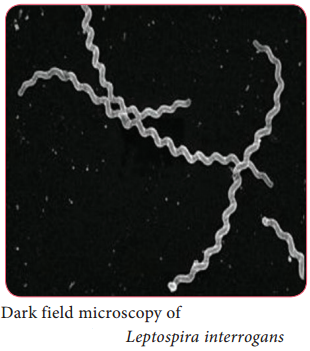Learninsta presents the core concepts of Microbiology with high-quality research papers and topical review articles.
An Overview Leptospira Interrogans
Spirochaetes of the genus Leptospira are actively motile, delicate and possess numerous closely wound spirals with characteristic hooked ends. Several Leptospires are saprophytes, while many are potential pathogens of rodents, domestic animals and humans. The genus Leptospira consists of two important
species, which are Leptospira interrogans and Leptospira biflexa.
Leptospira interrrogans is the causative agent of leptospirosis, a zoonotic disease. The word Leptospira is derived from Latin word ‘Leptos’ = fine or thin and ‘spira’ = Coil and interrogans = Question mark (The shape of this spirochete accounts for its name)
Morphology
- They are spiral bacteria (5-20µm × 0.1µm) with numerous closely set coils. Their ends are hooked and resemble umbrella handles.
- They are actively motile by rotatory movements. They cannot be seen under light microscope due to its thinness, best observed by dark fieldmicroscopy (Figure 7.24), phase contrast and electron microscope.
- They stain poorly with aniline dyes, it may be stained with giemsa stain or silver impregnation techniques.

Antigenic Structure
Leptospires show considerable antigenic cross reaction.
- Genus – Specific somatic antigen – It is present in all members of the genus.
- Surface antigens – This antigen is used to classify Leptospira into serogroups and serotypes.
Pathogenicity
Source of infection:
Contaminated water
Route of entry:
Through cuts or abrasions on skin or mucosa
Incubation period:
6-8 days
- Leptospira interrogans causes a zoonotic disease named Leptospirosis. It is transmitted to humans by direct or indirect contact with water, contaminated by urine of carrier animals (rat and dog).
- Leptospira enter the body through cuts or abrasions on skin or through mucous membranes of the mouth, nose or conjunctiva.
- After an incubation period of 6-8 days. There is onset of febrile (related to fever) illness with Leptospira in blood (Septicemic phase) which lasts for 3-7 days.
- The organisms disappear from the blood and invades liver, kidney, spleen, meninges producing meningeal irritation such as headache, vomiting.
- The pathogen persists in the internal organs and most abundantly in the kidney. Severe Leptospirosis (Weil’s disease) is associated with Fever, conjunctivitis (inflammation of conjunctiva), albuminuria (presence of albumin in the urine), jaundice and hemorrhage. It is a fatal illness with hepatorenal (Kidney failure with severe liver damage).
Clinical manifestations
- In severe cases, vomiting, headache, irregular fever and intense infection of the eyes.
- Jaundice, Albuminuria (The presence of protein Albumin in the urine) and purpuric hemorrhages sometimes occur on skin and mucosa.
Laboratory Diagnosis
The diagnosis of Leptospirosis is made by the following ways
- Direct microscopy of blood or urine
- Isolation of pathogen by culture
- Serological tests.
Direct Microscopy
Blood:
Leptospira can be observed in the blood by dark – filed microscope. Blood examination is useful in first week as Leptospira disappear from blood after 8 days.
Urine:
Leptospira may be present in urine in the 22nd week of the disease and intermittently thereafterup to 6 weeks. Centrifuged deposit of urine may be observed by Dark filed microscopy.
Culture:
Blood (1st week) and urine (22nd – 6 week) can be cultured in Korthof ’s medium. Media are incubated at 37°C for 2 days and then left at room temperature for 2 weeks. Culturesare examined every third day for the presence of Leptospira under DFM.
Serological tests
It is very useful method of diagnosis two types of serological tests are used, which are,
a. Screening tests:
These tests are genus – specific and done using reactive genus specific antigen (non – pathogenic L. biflexapatoc I strain).
Screening test includes – CFT, ELISA, SEL, HAT indirect IF these tests are capable to detect IgM and IgG leptospiral antibodies.
b. Serotype specific tests:
These tests identify the infecting serovar by demonstrating specific antibodies.
- Macroscopic agglutination test
- Microscopic agglutination test
Treatment and Preventions
- Leptospira are sensitive to penicillin and tetracycline.
- Preventive measures include rodent control, disinfection of water.